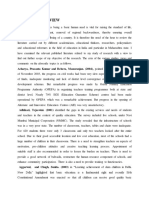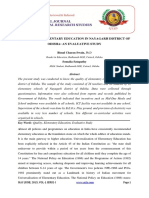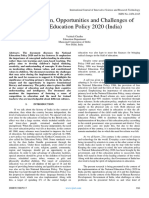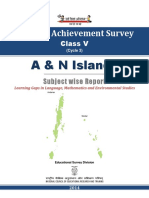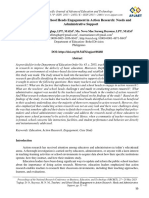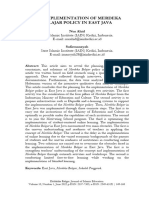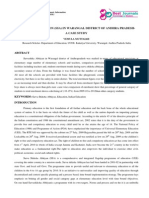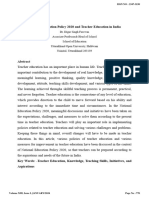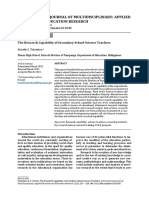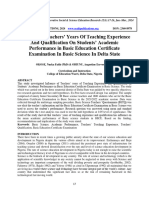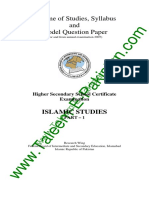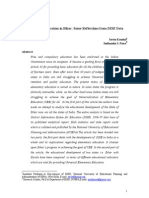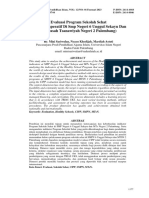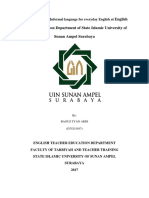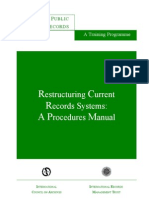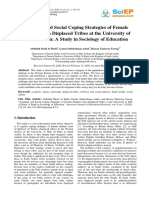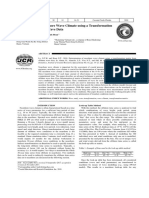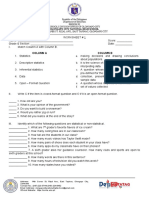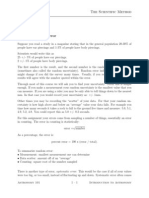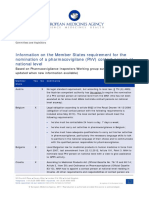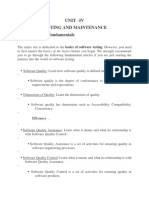Professional Documents
Culture Documents
A Study On Elementary Education Programme Operated Under Samagra Sikshya Abhiyan in Cuttack District
Original Title
Copyright
Available Formats
Share this document
Did you find this document useful?
Is this content inappropriate?
Report this DocumentCopyright:
Available Formats
A Study On Elementary Education Programme Operated Under Samagra Sikshya Abhiyan in Cuttack District
Copyright:
Available Formats
Volume 8, Issue 3, March – 2023 International Journal of Innovative Science and Research Technology
ISSN No:-2456-2165
A Study on Elementary Education Programme
Operated Under Samagra Sikshya Abhiyan in
Cuttack District
Dr. Ajay Kumar Swain, OES-I (C.B) Dr. Premananda Biswal, OES-I (CB)
Assistant Professor in Teacher Education Associate Professor in Education
NKC CTE. Angul, Odisha Department of Higher Education
Govt. of Odisha, Bhubaneswar
Abstract:- The present study was conducted to find out the (1992) took important policy decisions to augment the pace of
status of Elementary Education Programme in Cuttack. UEE through widespread programmes. Again it got an
The objectives were to study the functions of Elementary International acknowledgement at Education for All (EFA) in
Education operated under SSA in Cuttack district with 1991.Further in 1994; DPEP an experiment on quantitative
reference to Physical facilities, Institutional inputs, expansion and qualitative improvement in the field of UEE
Achievement, Community participation and Supervision played a vital role in cementing the comprehensive and
and to study the challenges and find out different strategies compulsory education. The success of DPEP opened a new
for improving Elementary Education in Cuttack district. 20 framework that is SSA to enlarge the National objective. The
numbers of schools, 40 teachers, 80 students and 40 parents UEE, a revolution in Indian education when the long cherished
were selected from urban and rural areas to conduct this dream , ”The Fundamental Right to Education” under article
study. The study revealed that there is a growth of SSA in 21(A) announced under the constitutional amendment by the
Cuttack on the matter of various interventions. But all Government of India (GOI),SSA a became a basic to implement
reported that the development of rural areas is far from the programmes related to UEE within a target time frame. But
satisfaction. From the data collected from the respondents there are so many challenges to realize the big mission of UEE
may not be true but the findings as per the field visit, taking through SSA in the country. Especially in Odisha, it has to face
responses from the higher authority, public and from the many hurdles to achieve the goal. This study is about the growth
secondary data available the investigator come to know the and status of Samagra Shiksha Abhiyan (SSA) in realizing the
real picture of the progress of SSA activities. goal of the nation, UEE in Cuttack district of Odisha. The focus
is on what has been happening in the district in regards to SSA
I. INTRODUCTION and what different authorities, the teachers’ community
members, parents, students think about the SSA. It is an
In India, education has been ensured as fundamental right assessment of the programmes of the Government, the State as
of the children under 6-14 age group in order to boost the well as the Centre, and the successes and failures as seen
mission of Universalisation of Elementary Education (UEE). A through the stakeholders, parents, students of elementary
centrally sponsored holistic approach SSA has been launched education.
during November; 2000.The scheme covers the entire nation
meeting with the needs of 192 million children in 11 lakh II. RATIONALE OF THE STUDY
habitations through 8.5 lakh existing schools and 33 lakh
teachers. As a people’s mass movement for qualitative and Elementary schools are functioning under SSA and are
quantitative expansion and improvement on the line of District managed by state government. Most of the dropouts are found
Primary Education Programme (DPEP), SSA has a long road to in government schools which are running under SSA. The
contribute India’s socio-economic development. Really India probable reasons for the non-enrolment, irregular retention and
has been considerably developing in the field of education since school dropout might be due to the poverty, migration of
Independence. In spite of spectacular initiatives, plans and parents, lack of positive parental attitude for studies of their
programmes to pace the elementary education up to the children, frequent physical sickness because of malnutrition
international standard it has been facing many challenges. It has and lack of better hygiene, lack of awareness of parents, broken
been experienced that education is the most suitable panacea to families, and domestic work, sibling care and other compelling
face the modern dynamic challenges of the world in which reasons for the children which made them to remain out of
elementary stage is the base the entire superstructure. It was a school system. In view of the above discussions, the present
turning chapter in the history of education when the National study seeks to address itself to the following questions.
Policy on Education (NPE) 1986 and Programme of Action
IJISRT23MAR199 www.ijisrt.com 246
Volume 8, Issue 3, March – 2023 International Journal of Innovative Science and Research Technology
ISSN No:-2456-2165
Is there any change revealed in the school environment, The area of the study was delimited to Cuttack district. In
physical facilities and achievement of learners due to SSA this study both rural and urban areas were taken into
at elementary stage of Cuttack district? consideration. 20 numbers of schools, 40 teachers, 80 students
Whether the change in the process of administration and and 40 parents were selected from urban and rural areas to
management helped in bringing about qualitative and conduct this study.
quantitative improvement in elementary education?
Is SSA helped in meeting the problems and challenges of Instruments:
the educational institutions? Questionnaire: Four sets of questionnaire were developed.
Is there any improvement witnessed in the enrolment, One questionnaire for sampled teachers.
student’s study habits and participation in classroom Interview schedule: There were two sets of Interview
activities due to SSA? scheduled developed for the purpose. One for student and
another for parents related to school.
In order to seek the answers to the above research
questions, the investigators thought it worthwhile to undertake Preparation of Tools
the present study entitled as “A Study on Elementary The draft of the tools developed by the investigators were
Education Programme Operated under Samagra Sikshya put before with five experts from RNIASE and DIET, Cuttack,
Abhiyan in Cuttack District”. Pedagogy coordinator of the district and Research scholars of
DIET, Cuttack.
Operational Definitions:
Elementary Education: The education that is given to the Procedure of Data Collection
children of age group 6-14 years from class I to VIII With the prior permission from District Education Officer
including primary and upper Primary level is termed as and heads of the institutions the data was collected. Adequate
elementary education in India. rapport was established through personal contact with
Samagra Sikshya Abhiyan: Samagra Shiksha Abhiyan Teachers, Students and parents. The purpose of the study was
(SSA) is Government of India's flagship programme for explained to them. The questionnaires were individually
achievement of Universalization of Elementary Education administered to the subjects. Respondents were assured of
(UEE) in a time bound manner, as mandated by 86th confidentiality of their responses.
amendment to the Constitution of India making free and
compulsory Education to the Children of 6-14 years age IV. ANALYSIS AND INTERPRETATION
group, a Fundamental Right.
Results obtained on administration of tools on the subjects
Objectives of the Study: need systematic analysis and interpretation to get the answers
The objectives of the study were: to the research questions.
To Study the functioning of Elementary Education operated
under SSA in Cuttack district with reference to Physical Perception of Teachers on interventions provided by SSA
facilities, Institutional inputs, Achievement, Community Entire success of SSA will go to teachers for their sincerity
participation and Supervision. and dedication on duty. For the present study 80 teachers were
To study the challenges and find out different strategies for selected from 4 blocks to assess the effect of SSA for fulfilling
improving Elementary Education in Cuttack district. the goals of UEE in Cuttack district. They were provided a
questionnaire to fill up and also interviewed to get qualitative
Delimitations of the Study: data.
The study was confined to the Elementary schools operated
by the SSA of Cuttack district only. Personal information
The teachers were asked to give their qualification and
The study was conducted in 20 SSA schools of Cuttack
experience and the data is produced here for analyses in tables
district only.
Table-1 Experience Configuration of sample Teachers (No.40)
III. METHODOLOGY
Particulars value
Keeping in view of the nature of the problem the Teaching experience mean in year 16.4
investigator followed Descriptive Survey design. This study is Teaching experience range in year 04-25
based on the interview method. The investigator paid a visit to
teachers, students and parents. He also had interaction with It can be said from the table 1 about the teaching
them through face-to-face mode i.e interviews to elicit experience of the sample teachers that their teaching experience
necessary information for the study. mean value is 16.4 and range is 4-25 years. It shows that their
Population and Sample experience is good enough to teach properly according to the
pedagogic interventions in the classroom. in Cuttack there are
IJISRT23MAR199 www.ijisrt.com 247
Volume 8, Issue 3, March – 2023 International Journal of Innovative Science and Research Technology
ISSN No:-2456-2165
different category teachers area teaching. The new teachers are should be provided in an example basis for others. Teachers
highly skilled and take interest and zeal to teach properly. But teaching in tribal and rural areas must get some special
in rural areas they give less interest in teaching. Hence it can be allowance as a morale booster. They have reported that they
suggested that teachers should be accountable and develop have received TLM training once in the past three year which
dedication on their prime duty of teaching for giving justice to is insufficient. It is suggested that special workshop should be
the students and society. organized in a cluster for teachers once in a year and there must
be sufficient storage provision for TLM in every schools. While
Table 2 Qualification configuration of sample Teachers preparing TLM the respondent viewed that they make
(No.40) discussion with Headmaster, other colleagues and students on
Qualification Frequency Percentage preparation and use of TLM. Sometimes they jointly prepare
Secondary 02 05 TLM with the help of students. In 20-30% schools there is
Higher secondary 20 50 proper provision of TLM banks in active stage observed by the
investigator.
Graduation (ARTS) 06 15
Graduation (Science) 04 10 Role in MDM
M.A 06 15 Teachers play an important role in MDM programme in
M. Sc. 02 05 the school. They reported that they supervise the MDM
Professional qualification (D. 22 55 distribution, taste the quality of the food, present during MDM
El. Ed) distribution, observing cleanliness of the dining space and
B. Ed 16 40 reporting attendance and problems found in the distribution of
M. Ed 02 05 MDM.
Perception of students on interventions provided by SSA
Table 2 shows that there are no untrained teachers in
Students are the destiny maker of the nation. All the
Cuttack district. Most of the teachers belong to Arts background
activities are undertaken by focusing the students in our
and there are teachers completing higher qualification in the
schools. Students are the nucleus in the entire interventions of
district. Really teachers with good academic and professional
the SSA. Taking the importance of students, the investigator
qualification are the assets for the society and nation. High
included students (No.80) in the present study and collected
qualified youths are seen in the teaching profession is a good
their views on the functioning of elementary education under
indication for the success of UEE mission.
SSA in Cuttack district. 20 schools were selected and Focused
Group Discussion was conducted by taking 20 groups of
Incentive available
students. Their collective views were collected under 5 items
Various incentives are provided to the teachers time to
such as personal information, regularity, Study assistance, and
time. This is presented by the sample teachers in the following
infrastructural facilities. Their collective and group responses
way.
are analyzed in this section.
Table 3 Interventions provided to school by Teachers (No.40)
Personal information
SL. No Types of Interventions for % of For the study some personal data were collected from the
school availability sample students. Under 4 groups on the basis of class below V,
01 Guide book 100 class VI, VII, VIII was fixed.
02 Incentives for teaching 00
03 Financial assistance 00 Table 4 Qualification configuration by students (No.80)
04 Training to teacher 75 Class of Students Frequency Percentage
05 Grant for TLM 100 Primary 20 25
Class VI 20 25
The table 3 shows that 100% teachers are provided guide Class VII 20 25
books (Sikshya Sathi), Samadhana, different modules for Class VIII 20 25
teaching effectively. They also receive 100% TLM grants of Total 80 100
Rs.500 per year to purchase and prepare teaching learning
materials for classroom teaching. Teachers perceived that they From the table 4, it can be pointed that 20 students of class
have got 75% trainings from different levels and still some V, VI, VII and VIII were randomly selected for the study. They
teachers require training in some specific subjects. No such reported that their all brothers and sisters are in government
provisions are there for financial assistance and incentive for schools in different class.
teaching. Sometimes prizes are distributed for good teachers’ at
district and state level. So it is suggested that teacher’s skill has
to be highlighted in different meeting, function. Incentive
IJISRT23MAR199 www.ijisrt.com 248
Volume 8, Issue 3, March – 2023 International Journal of Innovative Science and Research Technology
ISSN No:-2456-2165
Regularity: different items on the effect of SSA in their school. Their
responses are analyses in this section.
Table 5 Regularity of the teacher perceived by Students
(No.80) Personal Information.
Statement Frequency Percentage In the beginning some personal information was collected
Regularly coming 58 72.5 this includes qualification, occupation and preference of school.
Irregular 16 20 Following responses were collected
Cannot say 06 07.5
Total 80 100 Table 06 Qualification configuration by sample members
(No.40)
From the table 5, it is seen that 58% support teacher’s Qualification Frequency Percentage
regularity and only 16% viewed on irregularity. So it reveals Below secondary 12 30
that still some teachers are irregular mainly found in remote Secondary 12 30
schools where supervision is held occasionally. It is suggested Higher secondary 08 20
that proper monitoring and exchange of teacher can solve this Degree 05 12.5
situation. They express their inability to complain against
Higher qualification 03 07.5
irregularity of the teacher. On punishment following views
were collected. Total 40 100
Facilities available: Table 06 shows that most of the members and parents in
Students responded that they get facilities like MDM, SSA related schools are less qualified. Hence this is the main
Books, Uniform, and Kit bag at primary level. But uniform is criteria for not understanding the manifold interventions
not available for general boys. The government should provide provided by the government to the school. Parent’s higher
uniform to all irrespective of difference. Play materials are education is a positive factor for success of SSA.
scanty as viewed by most of the students.
Table 07 Preference of school by Members (No.40)
Study Assistance: Preference of school Frequency Percentage
In some cases urban students are guided by their parents SSA or Government 28 70
but it is rare in rural areas. Many parents prefer private tuition Non SSA or Private 12 30
in village for giving extra guidance for the children. In some Total 40 100
occasions competitions are organized in schools as perceived
by most of the students. It is suggested that teachers should give
On the question of preference of school for children they
a look into non scholastic areas of the learners. Only some
supported SSA school as stated in table 07. The frequency and
students participate in different competitions.
percentage was 70. It can be analyses that in most of the cases
rural and tribal parents prefer SSA school as it is totally free and
Infrastructural Facilities
not a burden on them.
On the question of toilet facilities boys don’t use toilets in
most of the schools due to lack of facility of cleaning. In most
Facility available
cases girls use toilet and in some schools toilets are in
On the question of facilities members supported the
unhygienic condition. Students agreed that they participate
interventions for their children. They agreed that Girls, SC, ST
actively in beautification of the school. They also viewed that
children at Upper primary level gets scholarship by the
only some teachers (30-40%) come to class with TLM and aids.
government. Books are received by students properly. No one
They feel proud as a student of Government school as they are
ask for money on any occasion as viewed by the respondents.
getting free education not giving burden to their parents. it is
realized that SSA interventions have made good standard in
Students’ Enrolment, attendance and dropout:
physical infrastructure but if quality will controlled students
From the perception of parents it is shown that they can
will get maximum benefit. A joint effort of all stake holders is
discuss on the attendance of the school with teachers and heads.
an urgent need of the hour.
In case of students absence matter is discussed in different
meetings. Through mobilization drop out can be checked
Perception Parents on Interventions Provided by SSA:
sufficient co curricular activities and attractive classroom
Parents play an effective role in making SSA successful.
teaching can improve regularity of the students as viewed by
It is seen due to lack of awareness and interest they do not take
them.
their responsibilities seriously. Therefore in the present
investigation views of community members are collected
through an interview schedule. Sufficient rapport was provided
to the respondent to give their open views and perception on 7
IJISRT23MAR199 www.ijisrt.com 249
Volume 8, Issue 3, March – 2023 International Journal of Innovative Science and Research Technology
ISSN No:-2456-2165
Evaluation from the secondary data available the investigator come to
On evaluation they perceived that 4 formative, unit test, 1 know the real picture of the progress of SSA activities these are
half yearly and one annual examination held in each session. listed below.
They want that evaluation system should be strict and it require Student’ absenteeism is found in rural area more than the
reform. urban area due to involvement of children in domestic work
and involve in parental occupation.
Role of School Committee Maintenance of MDM as a burden for teacher and teachers
There are different types of membership provision in SSA and head masters face difficulty to focus on teaching.
system. In the present investigation the sample members are Teacher resides at distance place. Residence facility is
categorized in the following way. required in cluster for regularity.
Text books are not supplied in time i.e. in the month of
Table 8 Configuration of Sample Members (No.100) April, the starting point of an academic session and old
Members Frequency Percentage books are not sufficient.
PTA/Parents 20 50 In rural pockets 30% irregular teachers are there which
MTA/Parents 20 50 shows a big problem in quality in SSA.
Total 100 100 For increasing enrolment of girls, SC/ST children some
innovative steps have been taken at block level such as
Table 8 shows that most of the respondents in the study parents’ counseling, vivid discussion with SMC/PTA/MTA
are PTA and MTA members (parents) comprising 50% and meeting , linking CRCC to the low enrolment schools.
50% respectively. They have attended training, SAHAYOGA No specific training has been provided for TLM to teachers
and it was helpful for them in knowing different provisions of for which a workshop should be organized at cluster level
SSA. On some special case they are also provided training at for better preparation of TLM.
BRCC and CRCC level. They were provided Rs 30 with a lunch Pedagogy training is given to the newly recruited teachers
per day for attending training. In every month The SMC calls and special training has provided to Gana Sikshyaka (GS).
meeting for strategic discussion on school matter. MTA and Topics discussed in the SMC meeting are regarding
PTA meeting held once in every 3 and 6 months. students’ regularity, teachers’ regularity, maintenance of
MDM, Utilization of governments fund, analysis of
Participation in School Activities assessment, school cleanliness and beautification etc.
Government grants are received for SIG, TLM, Uniform
Table 9 Role in school activity by Sample members (No.40) and Repairing and maintenance of the building and utilized
Statement Frequency Percentage properly.
Active participation in 26 65 It has been observed that literacy percentage has affected the
school activity enrolment ratio of different blocks of study area. In the
In active in school 14 35 blocks with higher percentage of literacy rate, the enrolment
activities ratio is also higher in comparison to the block where the
Total 40 100 ratio is low.
In all the blocks of the study the enrolment percentage is
The table 9 shows that 65% parent and members more than 95%.
participate in school activities actively and the percentage of SSA interventions have significant effect on enrolment of
inactive participants found in the study 35%. They support children
school in preparation of TLM (22%), helping teachers (8%), Under SSA uniforms have been distributed freely to girls
participate in cultural programmes (94%), beautification of the who resulted in enhancing their enrolment in schools.
school (47%) as per the perception of the respondents. They
School building, additional classroom have affected in
suggested that proper parent counseling, active teacher’s role
increasing the enrolment ratio.
and qualitative teaching will improve the standard of SSA and
student’s real knowledge and skill should be improved for their It has been observed that after SSA, spectacular growth of
better future.. infrastructural facilities has occurred in schools which have
also become helpful in increasing enrolment ratio of the
study area.
V. MAJOR FINDINGS OF THE STUDY
Due to organization of MTA,PTA under SSA the enrolment
From the perceptions of the respondents, it is found that ratio has also increased
there is a growth of SSA in Cuttack on the matter of various The role of SMC has a positive factor for the increasing
interventions. But all reported that the development of rural enrolment of the children.
areas is far from satisfaction. From the data collected from the Appointment of the teaching staff as per the norm of SSA
respondents may not be true but the findings as per the field has a positive impact on the enrolment of children.
visit, taking responses from the higher authority, public and
IJISRT23MAR199 www.ijisrt.com 250
Volume 8, Issue 3, March – 2023 International Journal of Innovative Science and Research Technology
ISSN No:-2456-2165
Enrolment of girl child has increased due to construction of allocation fund for conducting different work should be done
toilet in the school. before hand. The problems on SSA is not confined in Cuttack
Due to free text books distribution there is increasing of district only bur it is the problem of all district. A look into the
student enrolment under SSA. study can help everybody to get an insight on the functioning of
Training of community members has a positive impact on the SSA and solutions for future course of action.
the growth of enrolment of children.
Under SSA special infrastructure facilities has increased the REFERENCES
enrolment of learner with special need.
SSA has significant impact on the retention of the children [1]. Eswaran S. and Singh, A. (2008). – Teacher Absence in
It has been observed that the rate of retention has increased Primary Schools A Study. New Delhi. All India Primary
due to MDM in rural blocks. ?Teachers' Federation
Due to parent’s involvement and awareness the rate of [2]. Eswaran S. and Singh, A. (2008). – A Study of
retention has increased. Effectiveness of In-Service Education of Teachers. New
?Delhi. All India Primary Teachers'
Due to involvement of SMC/PTA/MTA there is a growth of
[3]. Federation Educational Consultants India Limited.
the retention of children in schools.
(2008). Study of Teachers’ Absence in Primary and Upper
Due to free text books and uniform there is a growth of
Primary Schools - Abridged Report of Study Conducted
retention in Cuttack district.
in 3 States. New Delhi:
Child friendly environment and punishment free system [4]. Kumaran,S. (2006). Effectiveness of SSA Training
increases retention of the children after SSA. Programmes on Academic Awareness, Classroom
Implementation of SSA in Cuttack district has significant Practices and Reactions of Upper Primary Teachers about
effect on achievement of learner in primary school. SSA Training Programmes in Thiruchuli Block,
Due to appointment of sufficient number of teachers and Virudhunagu District. Unpublished M. Ed. Dissertation,
lady teachers in elementary level under SSA has resulted in RIE Mysore.
increasing achievement level of the children. [5]. Menon,P .(2008) A comparative analysis of the forms of
Activity based learning has a greater role on achievement community engagement in SSA in
level of the student. [6]. OPEPA, (2010). “Research Abstracts, VOL. X
It has been observed that availability of teaching equipment [7]. Panda, S.K. (2008). development of primary education in
and TLM has affected the achievement of the learners. Punjab, Role of community, DEP, SSA, New Delhi ,
Achievement of the learner has also affected by the IGNOU
involvement of community members and parents [8]. Raju, S.M.D & Jyoti, A (2007). Causes for dropouts of
involvement. girls child education and community awareness in
general, SC/ST and miniority sections in particular,
VI. CONCLUSION community mobilization, An aspects of Quantity
improment DEP-SSA, New Delhi, IGNOU
Another problematic field is found with teacher. Teachers’ [9]. Sahoo, D. (2012). Effect of Quality intervention of SSA
absence from their school reduces teaching hours. To improve on elementary education in the state of Odisha.
schooling quality, there is a need to increase teachers’ teaching [10]. Saikia, A. (2009). – Wastage and Stagnation in
hours. To increase teachers’ teaching hours, there is a need to Elementary Education: A Comparative Study of
reduce suitably the duration of in-service training being Dibrugarh and Tinsukia District of Assam
imparted to teachers every year under Samagra Shiksha [11]. Saikia ,A. (2009). – A Comparative Study of Elementary
Abhiyan (SSA). This is because hardly any substitute teacher is Education in Assam and Arunachal Pradesh, Ph. D Thesis
posted in school when a teacher is under in-service training. [12]. Singh,R, P.(2007).“Elementary Education and Literacy in
Teachers were engaged in nonprofessional work. Teachers India”, Yojana, September, Vol.51
should not be engaged in non-professional duties. This measure [13]. Singh, G.(2010).“Progress of Human Development in the
would further improve teachers’ teaching hours in schools. Changing Scenario”, Kurukshetra, A Journal of Rural
Teachers should be dedicated enough to to prove as a beacon Development, Vol. 58, No 11
light for the education and society. Right attitude and [14]. Singh, Y. (2008) Community and Schooling in India same
enthusiasm in all activity with interest can make SSA a sociological issues, paper at National Seminar New Delhi.
successful weapon to curb all maladies. NEUPA
[15]. Browsing internet
Educational authorities must plan properly for proper
implementation of SSA interventions in the target area and
authority. Books should be provided in time so that authority at
grass root level will not face difficulties. Curriculum revision,
new training module, innovations in teaching and research
programmes should be made focus area. Sufficient and timely
IJISRT23MAR199 www.ijisrt.com 251
You might also like
- NCT DreamDocument12 pagesNCT DreamLipi LipiNo ratings yet
- Dr. Susanta Kumar Nayak PDFDocument11 pagesDr. Susanta Kumar Nayak PDFDesh Vikas JournalNo ratings yet
- Best Practices in Brigada Eskwela of Secondary Schools in Batangas ProvinceDocument8 pagesBest Practices in Brigada Eskwela of Secondary Schools in Batangas ProvinceIOER International Multidisciplinary Research Journal ( IIMRJ)No ratings yet
- Curriculum Management As Strengthening Pancasila Students ProfilesDocument7 pagesCurriculum Management As Strengthening Pancasila Students ProfilesAJHSSR Journal100% (1)
- EducationpaperDocument26 pagesEducationpaperrakhee mehtaNo ratings yet
- Educator's Challenges and Experience in Implementing Screening in Grade R Classrooms in Dr. Kenneth KaundaDocument5 pagesEducator's Challenges and Experience in Implementing Screening in Grade R Classrooms in Dr. Kenneth KaundaInternational Journal of Innovative Science and Research TechnologyNo ratings yet
- Summary of Research ReportsDocument240 pagesSummary of Research ReportsStatistics Office MakwanpurNo ratings yet
- BaLA Project ReportDocument65 pagesBaLA Project ReportpriyaNo ratings yet
- Problems of Elementary Education in Valsad District of GujaratDocument3 pagesProblems of Elementary Education in Valsad District of GujaratEditor IJTSRDNo ratings yet
- The Implementation of Indigenous Peoples Education (IPED) Program Towards A Proposed Plan of ActionDocument12 pagesThe Implementation of Indigenous Peoples Education (IPED) Program Towards A Proposed Plan of ActionAPJAET Journal100% (2)
- Jurnal Inkury 2Document7 pagesJurnal Inkury 2Sakirah QiraNo ratings yet
- Bimal CharanDocument9 pagesBimal CharanINTERNATIONAL JOURNAL FOR EDUCATIONAL RESEARCH STUDIESNo ratings yet
- Implementation, Opportunities and Challenges of National Education Policy 2020 (India)Document5 pagesImplementation, Opportunities and Challenges of National Education Policy 2020 (India)International Journal of Innovative Science and Research TechnologyNo ratings yet
- School Learning Action Cell (SLAC) Programh: The Batuan District ExperienceDocument9 pagesSchool Learning Action Cell (SLAC) Programh: The Batuan District ExperiencePsychology and Education: A Multidisciplinary JournalNo ratings yet
- Andaman&NicobarIslands PDFDocument76 pagesAndaman&NicobarIslands PDFAbirami santhanamNo ratings yet
- Teachers' and School Heads Engagement in Action Research Needs and Administrative SupportDocument11 pagesTeachers' and School Heads Engagement in Action Research Needs and Administrative SupportAPJAET JournalNo ratings yet
- An Evaluative Study of Sarva Shiksha AbhiyanDocument6 pagesAn Evaluative Study of Sarva Shiksha AbhiyanAnonymous CwJeBCAXpNo ratings yet
- 8 GALLEY Ahid+ (149 168)Document20 pages8 GALLEY Ahid+ (149 168)Muhammad Ayatullah Firman AuliaNo ratings yet
- Effects of Pedagogical Approaches & Practices For Sustainable Development in Early Childhood Education: A Research ReviewDocument9 pagesEffects of Pedagogical Approaches & Practices For Sustainable Development in Early Childhood Education: A Research ReviewAnonymous CwJeBCAXpNo ratings yet
- JPSP-2022-314Document9 pagesJPSP-2022-314ain nabihah05No ratings yet
- Gujarat PDFDocument54 pagesGujarat PDFRajesh RajparaNo ratings yet
- Physical Education Teachers' Performance in the New Normal of COVID-19Document14 pagesPhysical Education Teachers' Performance in the New Normal of COVID-19dharma raflesiaNo ratings yet
- Final RecordDocument96 pagesFinal Recordsairam898No ratings yet
- What Is The Current Scenario of Education System in India?Document8 pagesWhat Is The Current Scenario of Education System in India?Zippy GoyalNo ratings yet
- Manage-Rajiv Vidhya Mission-Vemula MuttaiahDocument6 pagesManage-Rajiv Vidhya Mission-Vemula MuttaiahBESTJournalsNo ratings yet
- Jan2024 1Document13 pagesJan2024 1Digar Singh FarswanNo ratings yet
- 96-Article Text-319-3-10-20210516Document12 pages96-Article Text-319-3-10-20210516ALINE MASIGONNo ratings yet
- Journal of Physical Education and Sports: Veni Imawati, Rumini & SulaimanDocument6 pagesJournal of Physical Education and Sports: Veni Imawati, Rumini & Sulaimanubaidillah affanNo ratings yet
- Early Childhood Education in Pakistan 2017Document75 pagesEarly Childhood Education in Pakistan 2017Zahoor KhanNo ratings yet
- A Study of Educational Facilities Available in District Institute of Education and Training in AssamDocument5 pagesA Study of Educational Facilities Available in District Institute of Education and Training in AssamresearchinventyNo ratings yet
- IJISSER-M-3-2024Document10 pagesIJISSER-M-3-2024Mynaijakings TVNo ratings yet
- Silo - Tips - Effects of Biology Practical Activities On Students Process Skill AcquisitionDocument12 pagesSilo - Tips - Effects of Biology Practical Activities On Students Process Skill Acquisitionangelinabarnett216No ratings yet
- 7 3 2023ArtikelJurnalJIIPDocument8 pages7 3 2023ArtikelJurnalJIIPNaniNo ratings yet
- Published Article VJESDocument12 pagesPublished Article VJESAlok SinghNo ratings yet
- Problems and Constraints of Authentic Assessment Among Children's Early Education TeachersDocument23 pagesProblems and Constraints of Authentic Assessment Among Children's Early Education TeachersWahyu HidayatNo ratings yet
- Makalah UksDocument8 pagesMakalah UksElfi SaharaNo ratings yet
- NEW 10TH PHYSICS SEM1Document174 pagesNEW 10TH PHYSICS SEM1Anand PasumarthiNo ratings yet
- Kinestetik: Jurnal Ilmiah Pendidikan Jasmani: Damrah, Suci Anita, Yuni Astuti, Pitnawati, Erianti, ZulbahriDocument13 pagesKinestetik: Jurnal Ilmiah Pendidikan Jasmani: Damrah, Suci Anita, Yuni Astuti, Pitnawati, Erianti, Zulbahridharma raflesiaNo ratings yet
- How To Improve The Pre-School Program? in The Case of ChinaDocument8 pagesHow To Improve The Pre-School Program? in The Case of ChinaЖа КаNo ratings yet
- Enhancing Student-Teachers' Capacity For Effective Teaching Practice and Autonomy of Secondary School Stuudents in Abia StateDocument15 pagesEnhancing Student-Teachers' Capacity For Effective Teaching Practice and Autonomy of Secondary School Stuudents in Abia StateTerem TebaNo ratings yet
- Islamic Studies HSSC I Syllabus and Model Question Paper FbiseDocument33 pagesIslamic Studies HSSC I Syllabus and Model Question Paper FbiseRao Mohsin FareedNo ratings yet
- An Investigation Into The Level of Expertise of The Staff in Implementing Policy On The Management of Public Early Childhood Development Education Centres in Elgeyo Marakwet County, KenyaDocument9 pagesAn Investigation Into The Level of Expertise of The Staff in Implementing Policy On The Management of Public Early Childhood Development Education Centres in Elgeyo Marakwet County, KenyaOIRCNo ratings yet
- Perception of Children About Continuous and Comprehensive Evaluation at Elementary School Level in OdishaDocument12 pagesPerception of Children About Continuous and Comprehensive Evaluation at Elementary School Level in OdishaAnonymous CwJeBCAXpNo ratings yet
- In-Service Teacher Education Programmes - An OverviewDocument7 pagesIn-Service Teacher Education Programmes - An OverviewAnonymous CwJeBCAXpNo ratings yet
- 162-Article Text-1685-1-10-20220131Document27 pages162-Article Text-1685-1-10-20220131Naiv Dela Cerna BarrantesNo ratings yet
- Elimentary Education in BiharDocument16 pagesElimentary Education in BiharRavi BariarNo ratings yet
- Mathematics Title, Table of Contents, Foreward PrefaceDocument7 pagesMathematics Title, Table of Contents, Foreward Prefacehamza_amjad14No ratings yet
- Effect of Child Centred Methods On Teaching and Learning of Science Activities in Pre-Schools in KenyaDocument9 pagesEffect of Child Centred Methods On Teaching and Learning of Science Activities in Pre-Schools in Kenyanuranis nabilahNo ratings yet
- National Achievement Survey: W e S T B e N G A LDocument48 pagesNational Achievement Survey: W e S T B e N G A LArunava PanditNo ratings yet
- Sarva Shiksha Abhiyan and Educational Development: July 2015Document10 pagesSarva Shiksha Abhiyan and Educational Development: July 2015Saket ChoudharyNo ratings yet
- Uttarakhand PDFDocument68 pagesUttarakhand PDFSubs NegiNo ratings yet
- PaltasinghBhue VoT July - Issue 2021Document11 pagesPaltasinghBhue VoT July - Issue 2021suzanna2002No ratings yet
- 3744 10353 1 PBDocument14 pages3744 10353 1 PBirawan adiiNo ratings yet
- Science-Learning Strengthening Model in Islamic Educational Institution: Case Study at MAN 1 YogyakartaDocument20 pagesScience-Learning Strengthening Model in Islamic Educational Institution: Case Study at MAN 1 YogyakartaIrham Rohib GibranNo ratings yet
- Ijcrt2204054 PDFDocument3 pagesIjcrt2204054 PDFTripti AtriNo ratings yet
- Role of Sarvashikshaabhiyan in Elementary Education DevelopmentDocument5 pagesRole of Sarvashikshaabhiyan in Elementary Education DevelopmentSaket ChoudharyNo ratings yet
- Factors Influencing Students' Attitude Towards Science Subjects in Secondary Schools A Case Study of Secondary Schools in Kisseka Sub County, Masaka District.Document14 pagesFactors Influencing Students' Attitude Towards Science Subjects in Secondary Schools A Case Study of Secondary Schools in Kisseka Sub County, Masaka District.KIU PUBLICATION AND EXTENSIONNo ratings yet
- Telaah Kurikulum SMP Tugas Review Jurnal Telaah Kurikulum SMPDocument15 pagesTelaah Kurikulum SMP Tugas Review Jurnal Telaah Kurikulum SMPkamariahNo ratings yet
- Comparatively Design and Analyze Elevated Rectangular Water Reservoir with and without Bracing for Different Stagging HeightDocument4 pagesComparatively Design and Analyze Elevated Rectangular Water Reservoir with and without Bracing for Different Stagging HeightInternational Journal of Innovative Science and Research TechnologyNo ratings yet
- Diabetic Retinopathy Stage Detection Using CNN and Inception V3Document9 pagesDiabetic Retinopathy Stage Detection Using CNN and Inception V3International Journal of Innovative Science and Research TechnologyNo ratings yet
- The Utilization of Date Palm (Phoenix dactylifera) Leaf Fiber as a Main Component in Making an Improvised Water FilterDocument11 pagesThe Utilization of Date Palm (Phoenix dactylifera) Leaf Fiber as a Main Component in Making an Improvised Water FilterInternational Journal of Innovative Science and Research TechnologyNo ratings yet
- Advancing Healthcare Predictions: Harnessing Machine Learning for Accurate Health Index PrognosisDocument8 pagesAdvancing Healthcare Predictions: Harnessing Machine Learning for Accurate Health Index PrognosisInternational Journal of Innovative Science and Research TechnologyNo ratings yet
- Dense Wavelength Division Multiplexing (DWDM) in IT Networks: A Leap Beyond Synchronous Digital Hierarchy (SDH)Document2 pagesDense Wavelength Division Multiplexing (DWDM) in IT Networks: A Leap Beyond Synchronous Digital Hierarchy (SDH)International Journal of Innovative Science and Research TechnologyNo ratings yet
- Electro-Optics Properties of Intact Cocoa Beans based on Near Infrared TechnologyDocument7 pagesElectro-Optics Properties of Intact Cocoa Beans based on Near Infrared TechnologyInternational Journal of Innovative Science and Research TechnologyNo ratings yet
- Formulation and Evaluation of Poly Herbal Body ScrubDocument6 pagesFormulation and Evaluation of Poly Herbal Body ScrubInternational Journal of Innovative Science and Research TechnologyNo ratings yet
- Terracing as an Old-Style Scheme of Soil Water Preservation in Djingliya-Mandara Mountains- CameroonDocument14 pagesTerracing as an Old-Style Scheme of Soil Water Preservation in Djingliya-Mandara Mountains- CameroonInternational Journal of Innovative Science and Research TechnologyNo ratings yet
- The Impact of Digital Marketing Dimensions on Customer SatisfactionDocument6 pagesThe Impact of Digital Marketing Dimensions on Customer SatisfactionInternational Journal of Innovative Science and Research TechnologyNo ratings yet
- A Review: Pink Eye Outbreak in IndiaDocument3 pagesA Review: Pink Eye Outbreak in IndiaInternational Journal of Innovative Science and Research TechnologyNo ratings yet
- Auto Encoder Driven Hybrid Pipelines for Image Deblurring using NAFNETDocument6 pagesAuto Encoder Driven Hybrid Pipelines for Image Deblurring using NAFNETInternational Journal of Innovative Science and Research TechnologyNo ratings yet
- Design, Development and Evaluation of Methi-Shikakai Herbal ShampooDocument8 pagesDesign, Development and Evaluation of Methi-Shikakai Herbal ShampooInternational Journal of Innovative Science and Research Technology100% (3)
- A Survey of the Plastic Waste used in Paving BlocksDocument4 pagesA Survey of the Plastic Waste used in Paving BlocksInternational Journal of Innovative Science and Research TechnologyNo ratings yet
- Cyberbullying: Legal and Ethical Implications, Challenges and Opportunities for Policy DevelopmentDocument7 pagesCyberbullying: Legal and Ethical Implications, Challenges and Opportunities for Policy DevelopmentInternational Journal of Innovative Science and Research TechnologyNo ratings yet
- Hepatic Portovenous Gas in a Young MaleDocument2 pagesHepatic Portovenous Gas in a Young MaleInternational Journal of Innovative Science and Research TechnologyNo ratings yet
- Explorning the Role of Machine Learning in Enhancing Cloud SecurityDocument5 pagesExplorning the Role of Machine Learning in Enhancing Cloud SecurityInternational Journal of Innovative Science and Research TechnologyNo ratings yet
- Navigating Digitalization: AHP Insights for SMEs' Strategic TransformationDocument11 pagesNavigating Digitalization: AHP Insights for SMEs' Strategic TransformationInternational Journal of Innovative Science and Research TechnologyNo ratings yet
- Perceived Impact of Active Pedagogy in Medical Students' Learning at the Faculty of Medicine and Pharmacy of CasablancaDocument5 pagesPerceived Impact of Active Pedagogy in Medical Students' Learning at the Faculty of Medicine and Pharmacy of CasablancaInternational Journal of Innovative Science and Research TechnologyNo ratings yet
- Automatic Power Factor ControllerDocument4 pagesAutomatic Power Factor ControllerInternational Journal of Innovative Science and Research TechnologyNo ratings yet
- Mobile Distractions among Adolescents: Impact on Learning in the Aftermath of COVID-19 in IndiaDocument2 pagesMobile Distractions among Adolescents: Impact on Learning in the Aftermath of COVID-19 in IndiaInternational Journal of Innovative Science and Research TechnologyNo ratings yet
- Review of Biomechanics in Footwear Design and Development: An Exploration of Key Concepts and InnovationsDocument5 pagesReview of Biomechanics in Footwear Design and Development: An Exploration of Key Concepts and InnovationsInternational Journal of Innovative Science and Research TechnologyNo ratings yet
- Studying the Situation and Proposing Some Basic Solutions to Improve Psychological Harmony Between Managerial Staff and Students of Medical Universities in Hanoi AreaDocument5 pagesStudying the Situation and Proposing Some Basic Solutions to Improve Psychological Harmony Between Managerial Staff and Students of Medical Universities in Hanoi AreaInternational Journal of Innovative Science and Research TechnologyNo ratings yet
- The Effect of Time Variables as Predictors of Senior Secondary School Students' Mathematical Performance Department of Mathematics Education Freetown PolytechnicDocument7 pagesThe Effect of Time Variables as Predictors of Senior Secondary School Students' Mathematical Performance Department of Mathematics Education Freetown PolytechnicInternational Journal of Innovative Science and Research TechnologyNo ratings yet
- Drug Dosage Control System Using Reinforcement LearningDocument8 pagesDrug Dosage Control System Using Reinforcement LearningInternational Journal of Innovative Science and Research TechnologyNo ratings yet
- Securing Document Exchange with Blockchain Technology: A New Paradigm for Information SharingDocument4 pagesSecuring Document Exchange with Blockchain Technology: A New Paradigm for Information SharingInternational Journal of Innovative Science and Research TechnologyNo ratings yet
- Enhancing the Strength of Concrete by Using Human Hairs as a FiberDocument3 pagesEnhancing the Strength of Concrete by Using Human Hairs as a FiberInternational Journal of Innovative Science and Research TechnologyNo ratings yet
- Formation of New Technology in Automated Highway System in Peripheral HighwayDocument6 pagesFormation of New Technology in Automated Highway System in Peripheral HighwayInternational Journal of Innovative Science and Research TechnologyNo ratings yet
- Supply Chain 5.0: A Comprehensive Literature Review on Implications, Applications and ChallengesDocument11 pagesSupply Chain 5.0: A Comprehensive Literature Review on Implications, Applications and ChallengesInternational Journal of Innovative Science and Research TechnologyNo ratings yet
- Intelligent Engines: Revolutionizing Manufacturing and Supply Chains with AIDocument14 pagesIntelligent Engines: Revolutionizing Manufacturing and Supply Chains with AIInternational Journal of Innovative Science and Research TechnologyNo ratings yet
- The Making of Self-Disposing Contactless Motion-Activated Trash Bin Using Ultrasonic SensorsDocument7 pagesThe Making of Self-Disposing Contactless Motion-Activated Trash Bin Using Ultrasonic SensorsInternational Journal of Innovative Science and Research TechnologyNo ratings yet
- Foundations 2023 L2 SlidesDocument68 pagesFoundations 2023 L2 Slidessharon oliverNo ratings yet
- Test EAPP Q2editedDocument6 pagesTest EAPP Q2editedApril Rose VicenteNo ratings yet
- Capital Budgeting Techniques Practices in BSRM and KSRM Company Ltd.Document42 pagesCapital Budgeting Techniques Practices in BSRM and KSRM Company Ltd.Edu WriterNo ratings yet
- Research Final ProjectDocument17 pagesResearch Final ProjectbagusNo ratings yet
- R C R A P M: Estructuring Urrent Ecords Systems: Rocedures AnualDocument70 pagesR C R A P M: Estructuring Urrent Ecords Systems: Rocedures AnualleapapayNo ratings yet
- Thesis Eng-Alat Berat CaterpillarDocument176 pagesThesis Eng-Alat Berat CaterpillarGaming BebasNo ratings yet
- American Journal of Educational ResearchDocument10 pagesAmerican Journal of Educational ResearchSt EfaniNo ratings yet
- Calculating Variance and Standard Deviation of Discrete Random VariablesDocument3 pagesCalculating Variance and Standard Deviation of Discrete Random VariablesGeosippi San Antonio LaymanNo ratings yet
- Ethical Issues Revenue Management PDFDocument2 pagesEthical Issues Revenue Management PDFTylerNo ratings yet
- Determination of Nearshore Wave Climate Using A Transformation Matrix From Offshore Wave DataDocument8 pagesDetermination of Nearshore Wave Climate Using A Transformation Matrix From Offshore Wave DataBenjamin HernandezNo ratings yet
- Levee Portfolio Report: U.S. Army Corps of EngineersDocument136 pagesLevee Portfolio Report: U.S. Army Corps of EngineersAmanda CervantesNo ratings yet
- Graded Assignment: Research Paper Planning AssignmentDocument2 pagesGraded Assignment: Research Paper Planning AssignmentAnonymous wiUldJzeNo ratings yet
- The Effect of Motivation On Organizational PerformanceDocument22 pagesThe Effect of Motivation On Organizational PerformanceZoraiz FazalNo ratings yet
- End of Chapter QuestionsDocument4 pagesEnd of Chapter QuestionsFritz NatividadNo ratings yet
- A Review On Prefabricated Multistory Structure: Faraz KhanDocument3 pagesA Review On Prefabricated Multistory Structure: Faraz KhanCarmelo Janiza LavareyNo ratings yet
- Forrester - A Simple Prioritization ModelDocument4 pagesForrester - A Simple Prioritization ModelSalvador Vazquez OlimonNo ratings yet
- Step 1: Choosing A Topic: Steps of The Research Writing ProcessDocument3 pagesStep 1: Choosing A Topic: Steps of The Research Writing ProcessJohn MisterioNo ratings yet
- Community Health ProfileDocument16 pagesCommunity Health ProfilecrainsnewyorkNo ratings yet
- Statistics Week 1Document3 pagesStatistics Week 1Jean MalacasNo ratings yet
- Portfolio RubricDocument2 pagesPortfolio Rubricapi-448518427No ratings yet
- Scientific Method: Piercing Survey AnalysisDocument3 pagesScientific Method: Piercing Survey AnalysisSharon Rose Genita MedezNo ratings yet
- Research Methods Are of Utmost Importance in Research ProcessDocument6 pagesResearch Methods Are of Utmost Importance in Research ProcessAnand RathiNo ratings yet
- A. Fractional CalculusDocument59 pagesA. Fractional CalculusJaime Feliciano HernándezNo ratings yet
- Optimization of Machining Parameters On AL 6061 Alloy Using Response Surface MethodologyDocument5 pagesOptimization of Machining Parameters On AL 6061 Alloy Using Response Surface MethodologySotu KdaptNo ratings yet
- Marx's Legacy in Historical SociologyDocument23 pagesMarx's Legacy in Historical SociologyUsu4riodoScribdNo ratings yet
- Bentuk Dan Ciri Adjektiva Bahasa Dayak Ngaju (Forms and Characteristics of Dayak Ngaju Language) Elisten Parulian SigiroDocument16 pagesBentuk Dan Ciri Adjektiva Bahasa Dayak Ngaju (Forms and Characteristics of Dayak Ngaju Language) Elisten Parulian SigiroNovitaNo ratings yet
- Information Member States RequirementDocument7 pagesInformation Member States RequirementAna ČevraNo ratings yet
- Question and Answer - 15Document31 pagesQuestion and Answer - 15acc-expertNo ratings yet
- Unit - Iv Testing and Maintenance Software Testing FundamentalsDocument61 pagesUnit - Iv Testing and Maintenance Software Testing Fundamentalslakshmi sNo ratings yet
- Knowledge-Based Dynamic Capabilities - A Scientometric Analysis of Marriage Between Knowledge Management and Dynamic CapabilitiesDocument35 pagesKnowledge-Based Dynamic Capabilities - A Scientometric Analysis of Marriage Between Knowledge Management and Dynamic CapabilitiesGil Santos DosNo ratings yet
